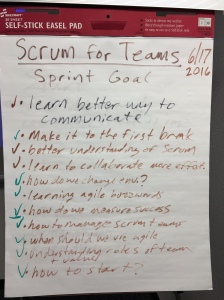
Is your Scrum team developing a solid set of goals for each sprint? If you are doing so how well is the team meeting the commitment?
Sprint goals are the most important first step in planning any sprint in Scrum. The Scrum team must come up with a set of goals to aspire to during the sprint. Without defined goals, the focus will land on simply achievement of completing the stories planned or a number of story points (or sizes of t-shirts or animals, whatever).
Having only stories or story points as a sprint goal is always a poor way to measure the success of a sprint. Mature scrum teams operate full-time in inspect & adapt (learning) mode. If the team has to make changes to the plan to adapt during a sprint then they must decide whether or not the desired outcome is still attainable. If the only measure is stories or story points then the plan is often far too malleable or strict (the extremes). Stories or points will simply be added or eliminated at the whim of the PO, the team, or even a manager. The result is the goal post has been moved and the purpose of using Scrum will be diminished.
That method is a great way to always be successful. But, it will not hold any water in almost all organizations or endeavors.
So let’s explore how to write goals for a sprint.
Writing a paragraph or two, or simply a list, defining the sprint goals is good Lean-Agile thinking and process for a Scrum team. The goals should meet the personal/professional development acronym SMART criteria. Stories are written with the guiding functions of the INVEST acronym.
From Wikipedia:
Ideally speaking, each corporate, department, and section objective should be:Specific – target a specific area for improvement.
Measurable – quantify or at least suggest an indicator of progress.
Assignable – specify who will do it.
Realistic – state what results can realistically be achieved, given available resources.
Time-related – specify when the result(s) can be achieved. (within a sprint!)
Notice that these criteria don’t say that all objectives must be quantified on all levels of management. In certain situations it is not realistic to attempt quantification, particularly in staff middle-management positions. Practicing managers and corporations can lose the benefit of a more abstract objective in order to gain quantification. It is the combination of the objective and its action plan that is really important. Therefore serious management should focus on these twins and not just the objective.
— George T. Doran, There’s a S.M.A.R.T. way to write management’s goals and objectives[2][3]
The team should create the goals and discuss them during the beginning phase of the sprint (or iteration) planning event (ceremony). Ask the hard questions. What does the team want to achieve during this sprint? What are the priorities of the product owner? What business objectives can the team support? Are there any other teams that our team can support this sprint? What dependencies, risks, and blockers exist in relation to possible goals being discussed? Quite often, after going through the prioritized product backlog and interacting with the product owner, a set of clear goals will emerge from the discussion. Write them down. Refine them a bit and make sure you write down how the team will measure success against the goals. Work with your product owner to gain acceptance of the sprint goals. Once you get a set of accepted sprint goals, don’t look back. Plan out your sprint backlog to meet the objectives and get to work. Run the experiment.
What are your thoughts about sprint goals?


